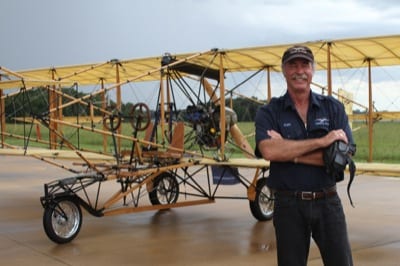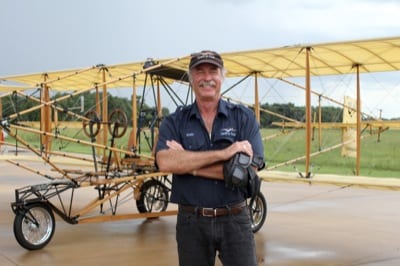The twin airfoil canard out front looks like a box kite, one of the prominent building materials is bamboo, and there was never a Pilot’s Operating Handbook of any kind produced for the airplane. However, when Kermit Weeks lines the Curtiss Pusher up on a 5,000-foot grass strip to take his first hop, heads turn and attention is being paid. It’s not every day you see an airplane from the earliest days of powered flight take to the air.
The airplane arrived at its new home at Fantasy of Flight in central Florida just recently to join Weeks’ ever-growing aircraft collection. Weeks and his crew of top-flight mechanics wasted little time assembling it and getting it ready to fly.
In many ways this collection of wires, wood, and fabric is a faithful reproduction of an original of the day. Understandably, there are a handful of modifications in the interest of safety.
 “This airplane was done by a guy named Dean Wilson,” says Weeks. “It was built for the 100th anniversary of the first airplane to fly in Idaho. It’s a two-seat Curtiss design.”
“This airplane was done by a guy named Dean Wilson,” says Weeks. “It was built for the 100th anniversary of the first airplane to fly in Idaho. It’s a two-seat Curtiss design.”
One of the modifications is found in the control system. Originally, the pilot manipulated the rudder by turning the control wheel, and made aileron inputs by leaning one way or the other to press on controls mounted at shoulder height. To avoid confusion and resulting control issues, the replica was built to accept control inputs that a modern pilot would understand and be comfortable with. That required the addition of a rudder bar, and the rigging of traditional aileron controls. The airplane also benefits from a more modern engine mounted into the airframe. “It’s got a Continental O-200 in it,” Weeks acknowledges. “A Cessna 150 engine.”
Even so, flying the Curtiss is not without its challenges. A pilot has to adapt a bit to flying an aircraft designed in the earliest era of powered flight.
The most important pitch indicator on the airplane is the canard out front. “It’s like an artificial horizon — literally,” says Weeks. “That becomes a very important reference for setting your pitch attitude for climbing and descending.”
The only instrument in the pilot’s view is an airspeed indicator taken from an ultralight. It’s essentially a tube with a plastic float in it that’s forced upward by ram air pressure to indicate airspeed. A string attached to the canard up front fills out what passes for an instrument panel. It’s the lowest tech instrument available, but it remains one of the most direct and efficient methods of determining slip in a flying aircraft. There’s no ball to step on, but there is a flying piece of string to guide your inputs.
Weeks’ description of actually flying the machine returns to a common theme. “It is very pitch sensitive,” he says.
Because there is no trim system on any axis, that pitch sensitivity remains throughout the entire flight. In fact it’s necessary to hold some forward pressure on the controls for the entire time the aircraft is airborne. There is no hands-off flying in a Curtiss design of this era.
It is Weeks’ extensive experience as an aerobatic pilot and his time behind the stick of so many different types of aircraft that the FAA ultimately issued him an unlimited Letter of Authorization that gives him an edge when flying what many general aviation pilots would consider to be a marginal airplane, at best. While the airframe has enough rigging to qualify it as a tall ship, it is both light and large. Its empty weight is a slim 723 pounds, with a gross weight that lists at only 1,200 pounds. Yet its biplane wings seem to extend outward to the horizon. There’s nothing conventional about flying this beauty of a museum piece.
 Like all aviation endeavors, Weeks treats the machine and the conditions with respect. He came out for the first hops in the Curtiss on a morning with no wind, flying off his own 5,000-foot grass strip. “I was sort of hopping it down the runway,” he says. “I think I got as high as tree top level a couple times. And then I would land it before I got to the end.”
Like all aviation endeavors, Weeks treats the machine and the conditions with respect. He came out for the first hops in the Curtiss on a morning with no wind, flying off his own 5,000-foot grass strip. “I was sort of hopping it down the runway,” he says. “I think I got as high as tree top level a couple times. And then I would land it before I got to the end.”
Because of the no-wind situation, he could simply turn the Curtiss around and point it in the opposite direction for the return trip. By doing these short hops Weeks got a feel for the control system, the speed envelope, and the basic flying characteristics of the airplane. When he finally developed the necessary confidence in the conditions, the airplane, and his ability to control it effectively, he made his first turn away from the runway and flew a circuit. Incrementally, his hops have gotten longer, eventually leaving the confines of Fantasy of Flight, his aviation-themed attraction located beside Interstate 4 in central Florida. In recent days he’s been stretching his legs a bit.
Should you find yourself on a major highway in Florida and think you are seeing things as you rocket past the gangliest airplane you have ever seen in your life — which is poking along in the air — don’t fret. You are not seeing things. Weeks is simply out having fun and racking up some flight time in the Curtiss.
Rest assured that if you do see the Curtiss in flight, you will very likely shoot past it quickly as you drive along the road. What the Curtiss is not is a speed demon. It cruises at a leisurely 45 miles per hour. Weeks reports that it’s a bit less squirrelly at 40, but the extra 5 miles per hour gives him some speed for those cross-country jaunts he’s been embarking on. Admittedly, with a fuel supply of only six gallons held in a cylindrical tube over his head, the cross-countries are not quite as lengthy as the average student pilot might attempt. But for a design that harkens from 1911, he’s seeing quite a bit of the countryside.
So far, Weeks has only flown the Curtiss solo, even though it has dual controls. It has a limitation imposed by the FAA that requires him to log 40 hours of flight in it before taking passengers aloft. But the idea of sharing the excitement and adventure of flying in a replica of one of the earliest viable airplane designs is clearly on his mind. “It will be interesting to see what happens when I do take two people up,” he says. “I’m sure it’d going to cut down some of the performance.”

Kermit,
I made the custom acid etched brass Curtiss Pusher serial and data plate for this airplane. Did it arive at your place with it, or did it stay with the builder in Idaho?